

Www.cdc.qc.ca/actes_aqpc/2005/ellis_joanne_608. Iptde.boisestate.edu/FileDepository.nsf/bf25ab0f47ba5dd785256499006b15a4/693b43c6386707fc872578150059c1f3/$FILE/Molenda_03.pdf. Uir.unisa.ac.za/bitstream/handle/10500/4245/04Chap 3_Learning and instructional systems design.pdf?sequence=5. Digitalcommons.unl.edu/cgi/viewcontent.cgi?article=1125&context=cehsedaddiss. How People Learn: Brain, Mind, Experience, and School: Expanded Edition. Ocw.metu.edu.tr/file.php/118/Week7/gustafson-branch2.pdf. Files.eric.ed.gov/fulltext/ED503906. Learning Theories of Instructional Design. Instructional Design Models. Instructional Design Models Models, like myths and metaphors, help us to make sense of our world.
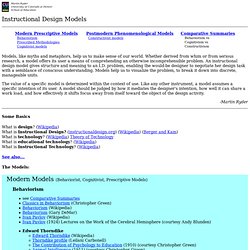
Whether derived from whim or from serious research, a model offers its user a means of comprehending an otherwise incomprehensible problem. Instructional Design Models and Methods. Instructional Design Models and Methods "Models, like myths and metaphors, help us to make sense of our world.

Whether derived from whim or from serious research, a model offers its user a means of comprehending an otherwise incomprehensible problem. An instructional design model gives structure and meaning to an I.D. problem, enabling the would-be designer to negotiate her design task with a semblance of conscious understanding. Models help us to visualize the problem, to break it down into discrete, manageable units. The value of a specific model is determined within the context of use. Review and compare various instructional design models and methods below: Merrill's First Principles of Instruction ADDIE Model Dick and Carey Model Kemp's Instructional Design Model Gagné's Nine Events of Instruction Bloom's Learning Taxonomy Kirkpatrick's 4 Levels of Training Evaluation Cathy Moore's Action Mapping. Wprowadzenie do metodyki medialnej - Instructional Design. Wprowadzenie do metodyki medialnej - Instructional Design "Powszechnym błędem popełnianym przez ludzi jest to kiedy próbują zaprojektować coś idioto-odpornego co udowadnia kompletne niedocenianie uzdolnień idiotów" (Douglas Adams) "Kurze jajko jest, po prostu, dziełem sztuki, majstersztykiem projektowania i struktury ze wsparciem znakomitego opakowania" (Delia Smith) "Najważniejszym faktem dotyczącym statku kosmicznego o nazwie Ziemia, jest to, że nie istnieje żadna dołączona instrukcja obsługi" (R.
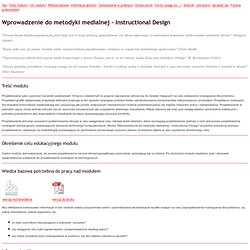
Buckminster Fuller) "Zawsze projektuj przedmioty zwracając uwagę na ich większy kontekst - krzesło w pokoju, pokój w budynku, budynek w jego otoczeniu, otoczenie budynku w kontekście miasta" (Eliel Saarinen) Przewodnik po e-learningu - Marek Hyla - Google Books. ADDIE Model. Learning objectives for this lesson: recognize the systematic process of the ADDIE model identify how the model can be applied to online course design What is instructional design?
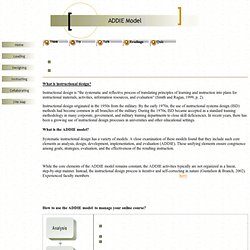
Instructional design is “the systematic and reflective process of translating principles of learning and instruction into plans for instructional materials, activities, information resources, and evaluation” (Smith and Ragan, 1999, p. 2). Instructional design originated in the 1950s from the military. Fog.ccsf.cc.ca.us/~mmalacho/OnLine/ADDIE.html. Office: S 316M Phone:415 452-5699 Email mmalacho@ccsf.edu Dr.
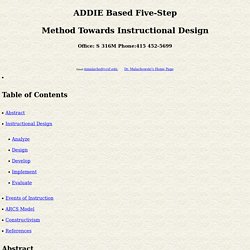
Malachowski's Home Page Table of Contents. Analysis. Introduction Just as builders and architects look at the land and find out about what the new homeowners want before they start building the home, you as a multimedia designer will begin your instructional media project by thinking about what you will create and why.

Who will use your project and why? What do they need to know or do? Use the ADDIE instructional design process to make sure that learners have a good instructional experience that does not happen in a haphazard way. This is a planned process so that the students who use your project will achieve the goals of your instruction. ID Intensive Home Page. Understanding By Design. "The purpose of a learner analysis is to discover or uncover the unique requirements/interests/aptitudes of individual student in order to maximize their learning experience.
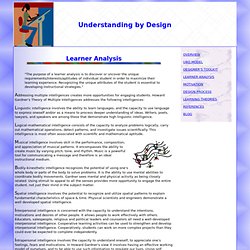
Recognizing the unique attributes of the student is essential to developing instructional strategies. " Addressing multiple intelligences creates more opportunities for engaging students. Howard Gardner's Theory of Multiple Intelligences addresses the following intelligences: Linguistic intelligence involves the ability to learn languages, and the capacity to use language to express oneself and/or as a means to process deeper understanding of ideas. Authentic Education - What is UbD™? Understanding by Design® (UbD™) is a framework for improving student achievement.

Emphasizing the teacher's critical role as a designer of student learning, UbD™ works within the standards-driven curriculum to help teachers clarify learning goals, devise revealing assessments of student understanding, and craft effective and engaging learning activities. Developed by nationally recognized educators Grant Wiggins and Jay McTighe, and published by the Association for Supervision and Curriculum Development (ASCD), Understanding by Design® is based on the following key ideas: A primary goal of education should be the development and deepening of student understanding. Students reveal their understanding most effectively when they are provided with complex, authentic opportunities to explain, interpret, apply, shift perspective, empathize, and self-assess. Understanding by Design. Overview Understanding by Design, an excellent book by Grant Wiggins and Jay McTighe, offers a powerful framework for designing courses through what they call “Backward Design.”
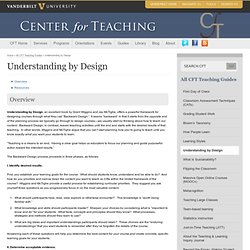
It seems “backward” in that it starts from the opposite end of the planning process we typically go through to design courses—we usually start by thinking about how to teach our content. Backward Design, in contrast, leaves teaching activities until the end and starts with the desired results of that teaching. In other words, Wiggins and McTighe argue that you can’t start planning how you’re going to teach until you know exactly what you want your students to learn. “Teaching is a means to an end. The Backward Design process proceeds in three phases, as follows: Understanding by Design® framework - Videos, Articles, Resources, Experts. Teaching and Learning Excellence. This is from a presentation at the 2005 Teaching Academy Summer Institute by Mitchell Nathan & Erica Halverson Adapted from Understanding by design and Understanding by design: Professional development workbook (Wiggins & McTighe, 1998, 2004).

We chose this framework for presenting course redesign because it embodies the principles of what we know about how people learn. Why is this called “backward design”? As novice designers, our instinct is often to start with a great learning activity that we know that really highlights a specific topic or skill. However, without a set of overarching learning goals and assessment strategies that help us understand whether or not students have reached these learning goals, and without a clear understanding of the knowledge students have coming prior to instruction, the activities themselves will likely be disconnected to each other and to learners’ prior knowledge, and therefore not likely to lead to robust learning for students.